Marvel Rivals vs Overwatch 2 Comparison: Ultimate Hero Shooter Breakdown
Updated On: October 25, 2025 by Aaron Connolly
Core Differences Between Marvel Rivals and Overwatch 2
These two hero shooters couldn’t be more different in how they approach camera perspective and the creative worlds they pull from. Marvel Rivals drops us into third-person action with iconic comic book legends, while Overwatch 2 keeps things in first-person with Blizzard’s own cast of heroes.
Key Genre and Perspective Contrasts
The first thing you’ll notice? How you actually play. Marvel Rivals puts the camera behind your character—think Fortnite or Gears of War.
You get to see your hero’s full look and all those flashy cosmetics during matches. Watching Spider-Man swing around or Hulk barrel through the map just feels right.
Overwatch 2 stays in first-person like a classic FPS. You’re seeing the world through your hero’s eyes, which amps up the immersion in firefights, but yeah, you don’t really see your outfit.
The pacing’s pretty different too. Marvel Rivals leans into slower, more tactical team fights where you’re always trying to combo superhero abilities with your squad.
Picture Hulk smashing through a wall while Iron Man blasts from above. That kind of teamwork.
Overwatch 2? It’s all about snappy reflexes and quick decisions. The first-person view makes every corner feel dangerous, especially when you’re up close.
Both games are free-to-play hero shooters. Marvel Rivals feels more like a superhero brawler, while Overwatch 2 is your classic competitive shooter.
Influence of Marvel and Overwatch Legacy
Marvel Rivals taps into decades of stories and characters. We all know Spider-Man’s wisecracks, Wolverine’s gruff attitude, and the rivalry between Iron Man and Cap.
You’ll jump into places like Wakanda or Asgard—all those Marvel locations fans love.
NetEase didn’t have to invent backstories from scratch. We already care about these heroes because we’ve seen them everywhere.
Overwatch 2 builds everything from the ground up. Every hero, from Tracer to Reinhardt, came from Blizzard’s imagination starting in 2016.
Their personalities and powers exist only in this universe. We learn about Winston’s science experiments or Mercy’s healing through the game itself.
Marvel’s fanbase gives it a head start. New players can instantly pick favorites based on comics or movies.
Gameplay Mechanics: Fresh Twists and Familiar Systems
Both games are hero shooters at heart, but Marvel Rivals shakes things up with destructible maps and team-up powers. Overwatch 2 leans into precise, role-based 5v5 combat, while Marvel Rivals prefers wild 6v6 chaos and blowing up the environment.
Combat Flow and Team Play
Marvel Rivals skips role locks and lets you swap heroes mid-match. If you start as Venom but need more firepower, just switch to Rocket Raccoon.
This keeps team comps unpredictable and matches feeling fresh.
The 6v6 format is a bit more forgiving for new folks. When you mess up your positioning, it’s easier for teammates to help you out than in Overwatch 2’s tighter 5v5 setup.
Overwatch 2 locks you into DPS, tank, or support from the start. It’s more structured, with each player having a clear job.
Playing tank is stressful—you’re the only one up front now. Support players have to watch their backs with fewer teammates around.
Combat pace? Totally different:
- Marvel Rivals: Fast, messy team brawls with wild ability combos.
- Overwatch 2: More methodical, with coordinated pushes and careful timing.
Synergy Abilities and Map Interaction
Marvel Rivals’ Team-Up system lets you pull off unique combos with certain pairings. Play Rocket Raccoon and Groot together, and you’ll unlock new moves.
These aren’t just stat boosts—they’re actual new mechanics.
Some favorite combos:
- Rocket + Groot: Better defense and shared movement
- Spider-Man + Venom: Cool web-slinging synergy
- Thor + Storm: Elemental attacks that look epic
These combos push you to experiment with team setups. There’s a lot of strategic depth here.
Overwatch 2 sticks to traditional ability interactions. Ana can boost a teammate, Zarya can shield, but it’s all about timing, not unlocking new moves.
The game focuses on how well you use your hero, not on combo powers. Coordination is about positioning and timing, not special pair mechanics.
Marvel Rivals makes these moments feel like blockbuster scenes. Overwatch 2 keeps things consistent and competitive.
Destructible Environments
Marvel Rivals lets you wreck the map as you play. Walls crumble, buildings collapse, and you can change the battlefield on the fly.
If you’re playing Hulk, you can literally punch through walls to flank enemies or smash cover.
This destruction totally changes how matches play out. Maps start with clear paths, but by the end, it’s just chaos.
Overwatch 2’s maps never change mid-match. Flanking routes and sightlines stay the same from start to finish.
This makes it easier to plan strategies and master maps, but you lose that wild, ever-changing feel.
Both styles have their perks—Marvel Rivals brings unpredictability, while Overwatch 2 gives you stability for competitive play.
Character Roster and Iconic Personalities

Marvel Rivals throws 37 famous heroes and villains into the mix, while Overwatch 2 keeps growing its list of 38 unique characters. The big difference? You already know Spider-Man, but you had to learn to love Tracer.
Marvel Characters and Fan Appeal
Marvel Rivals pulls from decades of comics and blockbuster movies. You’ll see Iron Man, Spider-Man, and Cap right away.
The roster mixes up X-Men like Storm and Wolverine with Guardians of the Galaxy favorites like Star-Lord and Groot.
It’s easy to get attached. Pick Hulk and you know you’re getting raw power and, well, a lot of smashing.
There’s more than just powers:
- Visuals match the comics and movies
- Voice lines shout out classic Marvel moments
- Team-ups feel right, like the Avengers or X-Men fighting together
You get 18 heroes and 19 villains at launch. Magneto, Venom, and Doctor Doom are instantly recognizable—something Overwatch 2 characters had to build over time.
Marvel characters also get a boost from new movies and shows. Every time there’s a new Marvel release, the game gets a little more buzz.
Original Heroes vs Familiar Faces
Overwatch 2 made its cast from scratch. Tracer, Mercy, and Reinhardt are gaming icons now, but it took years.
Blizzard could do whatever they wanted. They designed powers first, then built the hero’s story around them.
Overwatch heroes bring:
- Fresh backstories with no old lore to worry about
- Lots of diversity in backgrounds and personalities
- Abilities that define who they are—gameplay comes first
Marvel Rivals has to stick to the source. Spider-Man can’t suddenly fly, even if it would help balance.
So, Marvel gets instant appeal but less freedom to invent. Overwatch 2 earned its fans through gameplay, not nostalgia.
Both styles work. Marvel hooks you right away, but Overwatch builds loyalty over time.
Role Systems and Team Building

Both games sort heroes into roles, but Marvel Rivals is more chill about it. You get Vanguards, Duelists, and Strategists, while Overwatch 2 locks you into Tank, Damage, or Support. The difference? Marvel Rivals lets you mix things up mid-match.
Vanguard, Duelist, and Strategist Classes
Marvel Rivals keeps its class system loose. Vanguards soak up damage and lead the charge, kind of like tanks.
Duelists focus on taking out enemies fast. Strategists help the team with healing and utility.
The flexibility is great—you don’t have to stick to a set team comp. Stack Vanguards or skip them if you want.
Team-up powers can cross class lines. Hulk and Iron Man can combine moves, no matter what class they are.
This setup is perfect for experimenting, though sometimes it makes balancing a nightmare, especially in competitive play.
Tank, Damage, and Support Roles
Overwatch 2 keeps things strict with 5v5 role queue. You always need one Tank, a couple Damage dealers, and one or two Supports.
This keeps teams balanced but does kill some creativity. You can’t surprise the enemy with an all-healer squad or five tanks.
Role lock means you never end up with a team full of squishies or no healing at all. Every match feels organized.
Each player matters more in 5v5, compared to Marvel Rivals’ bigger teams. If someone’s having a bad game, it really shows.
Competitive players usually like this structure. It keeps things fair and easier to follow for tournaments.
Visual Style and Artistic Direction
Both games have their own strong looks. Marvel Rivals goes all-in on comic book style, while Overwatch 2 feels like a polished, futuristic animated movie.
Comic Book Flair vs Futuristic Aesthetic
Marvel Rivals looks like a comic book brought to life—bold colors, dramatic lines, and larger-than-life heroes.
Every character looks straight out of the comics or movies. You’ll see thick outlines and lighting that really pops.
Design details matter:
- Spider-Man swings just like in the comics
- Iron Man’s suit matches the MCU
- Maps have comic-inspired shading and textures
Overwatch 2 takes a smoother, more futuristic approach. Characters look like they came from a big-budget animated film.
It’s a bit more grounded, even with the sci-fi setting. The designs mix realism with stylized features, which works for a wide audience.
The colors are softer, less in-your-face than Marvel Rivals. This gives Overwatch 2 a more unified look across its maps and modes.
Animation, Colour, and In-Game Effects
Marvel Rivals really leans into explosive visual effects that make superhero powers pop. Every punch, blast, or ultimate ability comes off as dramatic and packs a punch.
You’ll notice the colour scheme uses a lot of bright reds, blues, and golds. It’s a bold choice that keeps the comic book vibe alive during gameplay.
Animation highlights:
- Characters move with exaggerated flair
- The screen shakes with heavy impacts
- Hits get comic-style visual feedback
Overwatch 2 takes a different approach, focusing on smooth, easy-to-read animations. Visual effects help players spot threats or opportunities right away.
They manage to balance flashy visuals with gameplay needs. Colours and effects never get in the way of the core shooting mechanics.
Animation quality stays high across all 37 heroes. Each hero moves in a way that fits their personality but still matches the overall art style.
Game Modes and Match Objectives
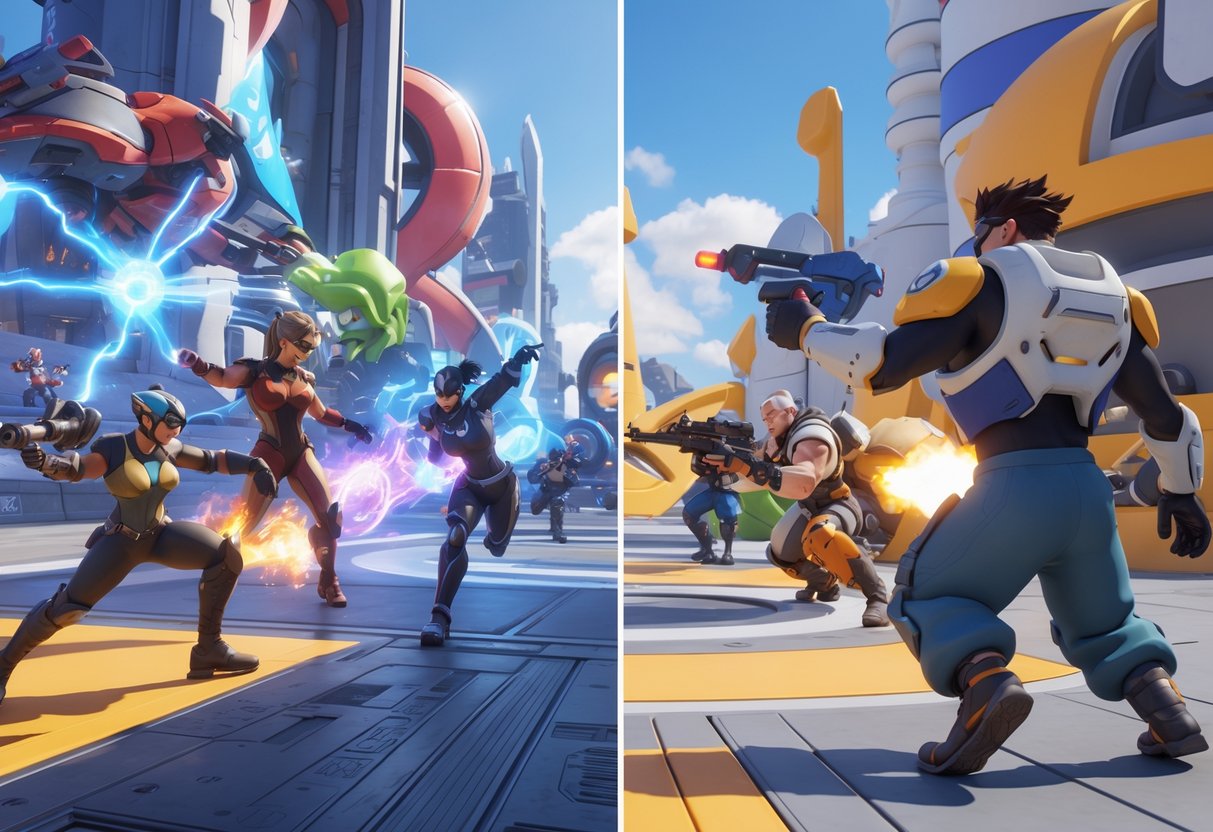
Marvel Rivals and Overwatch 2 both revolve around objective-based gameplay—think control points, escort missions, and hybrid modes. Overwatch 2 mixes things up more with seasonal events and arcade modes, while Marvel Rivals sticks closer to core competitive formats with the occasional themed event thrown in.
Objective-Based and Casual Modes
Control maps are the bread and butter for both games. Teams fight to capture points, but Marvel Rivals does it best-of-three on a single point. Overwatch 2 uses multi-point maps, so you’re racing to 100% capture on two different areas.
Escort missions work pretty much the same in both. Teams push payloads through checkpoints before the timer runs out. Marvel Rivals keeps this mode simple, while Overwatch 2 adds more checkpoints and changes up payload speeds.
Hybrid modes blend both objectives. You capture a point, then escort a payload. These matches usually last 15-20 minutes.
Marvel Rivals has its own Convoy mode. Teams take turns attacking and defending moving objectives. Overwatch 2 doesn’t have anything quite like this.
Both games offer Quick Play for more casual matches. Marvel Rivals lets you pick whatever role you want. Overwatch 2, on the other hand, locks you into strict role queues—damage, tank, or support.
Ranked modes in both games use the same basic objectives, but add skill-based matchmaking and seasonal ranks.
Unique Event and Seasonal Modes
Overwatch 2 leads the pack here, thanks to years of content updates. Arcade modes rotate every week—Mystery Heroes, Total Mayhem, 3v3 Elimination, and so on. The new Stadium mode even adds buy phases and buildcrafting between rounds.
Seasonal events bring out special modes during holidays. Junkenstein’s Revenge comes back every Halloween with PvE monster fights. Lúcioball shows up for Summer Games, letting you play football with abilities. Winter Wonderland means snowball fights.
Marvel Rivals keeps things simpler. Seasonal modes show up during big holidays, but there’s not as much variety as Overwatch 2. They focus more on dropping new characters than experimenting with wild new modes.
Custom games are a big deal in Overwatch 2, thanks to the Workshop. Players build their own rule sets and crazy game modes. Marvel Rivals doesn’t have any custom game tools yet.
Overwatch 2’s age really shows here. They’ve built up dozens of event modes since 2016. Marvel Rivals only just launched and is still building out its seasonal content.
Progression Systems and Player Rewards
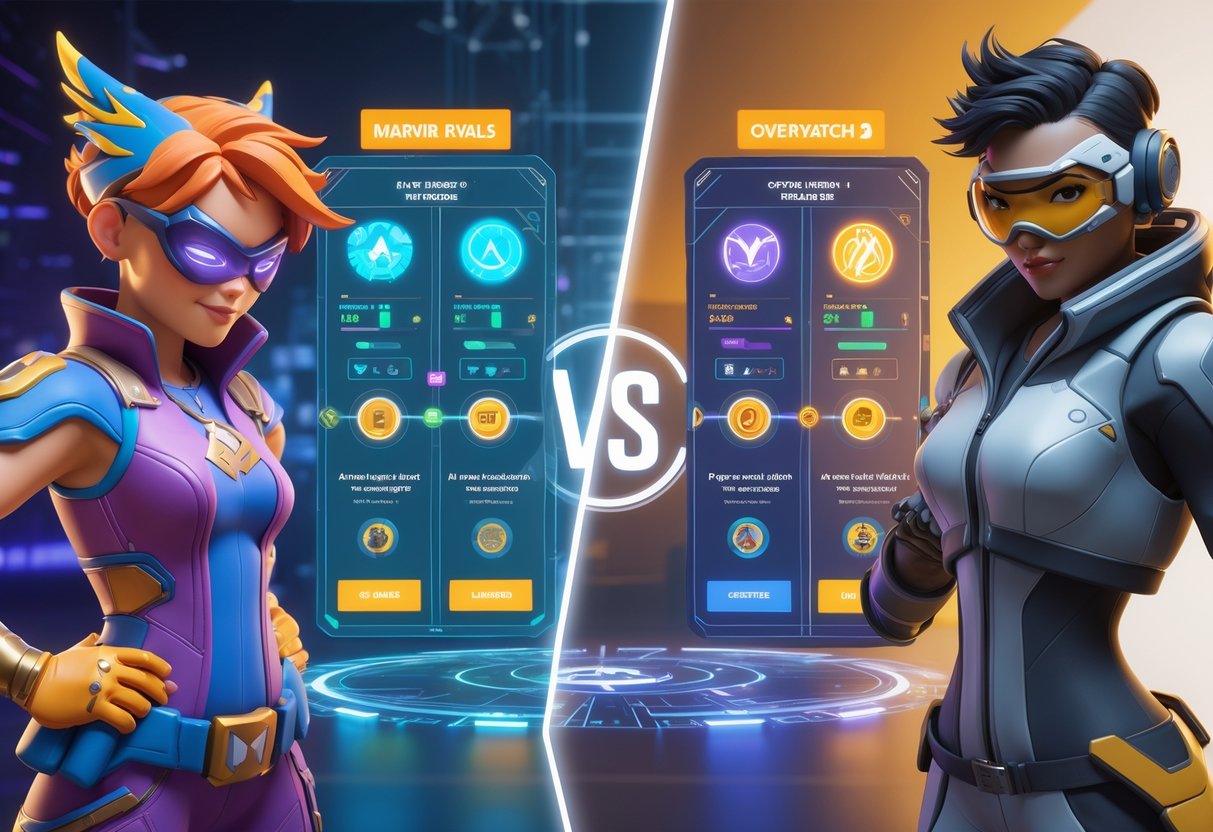
Marvel Rivals feels more generous with rewards and milestones than Overwatch 2’s grind-heavy setup. A lot of players say they’re happier with Marvel Rivals’ customisation options, while Overwatch 2’s progression just drags on.
Levelling and Unlockable Content
Marvel Rivals keeps progression player-friendly. Every match gives you something worthwhile, so you unlock meaningful content at a steady pace.
You get clear milestones without spending months grinding. New skins, icons, and abilities are all tied to gameplay achievements, not endless time sinks.
Marvel Rivals progression perks:
- Unlock paths for each character
- Team-up bonuses for group objectives
- Weekly challenges that actually pay off
- Free cosmetics just for playing regularly
Overwatch 2’s progression, honestly, grinds people down. Players complain about how long it takes to get even basic rewards.
The battle pass locks most content behind a paywall. If you’re playing for free, you’ll wait weeks to unlock even one cosmetic.
Overwatch 2 progression pain points:
- Slow battle pass progress
- Not many free rewards
- Titles take forever to earn
- Best stuff costs premium currency
Customisation and Milestone Achievements
Marvel Rivals stands out for giving players cool customisation. Unique character icons and personal touches actually feel special.
You can dress up Marvel heroes in comic-inspired skins. Every milestone gives you a visible reward to show off your progress.
The system caters to different playstyles. Whether you’re into team strategy or solo challenges, there’s something to unlock.
Popular customisation options:
- Character portraits for each hero
- Emotes and victory poses add personality
- Weapon skins for flashy abilities
- Title cards to show off achievements
Overwatch 2, by comparison, just doesn’t offer as much. The prestige system takes ages to reward you.
A lot of cosmetics can only be bought with real money. That’s frustrating if you want to earn stuff by playing well.
Season 18 promises better progression rewards, but players aren’t convinced that’ll fix the grind.
Monetisation Models: Free-to-Play, Cosmetics, and Battle Passes
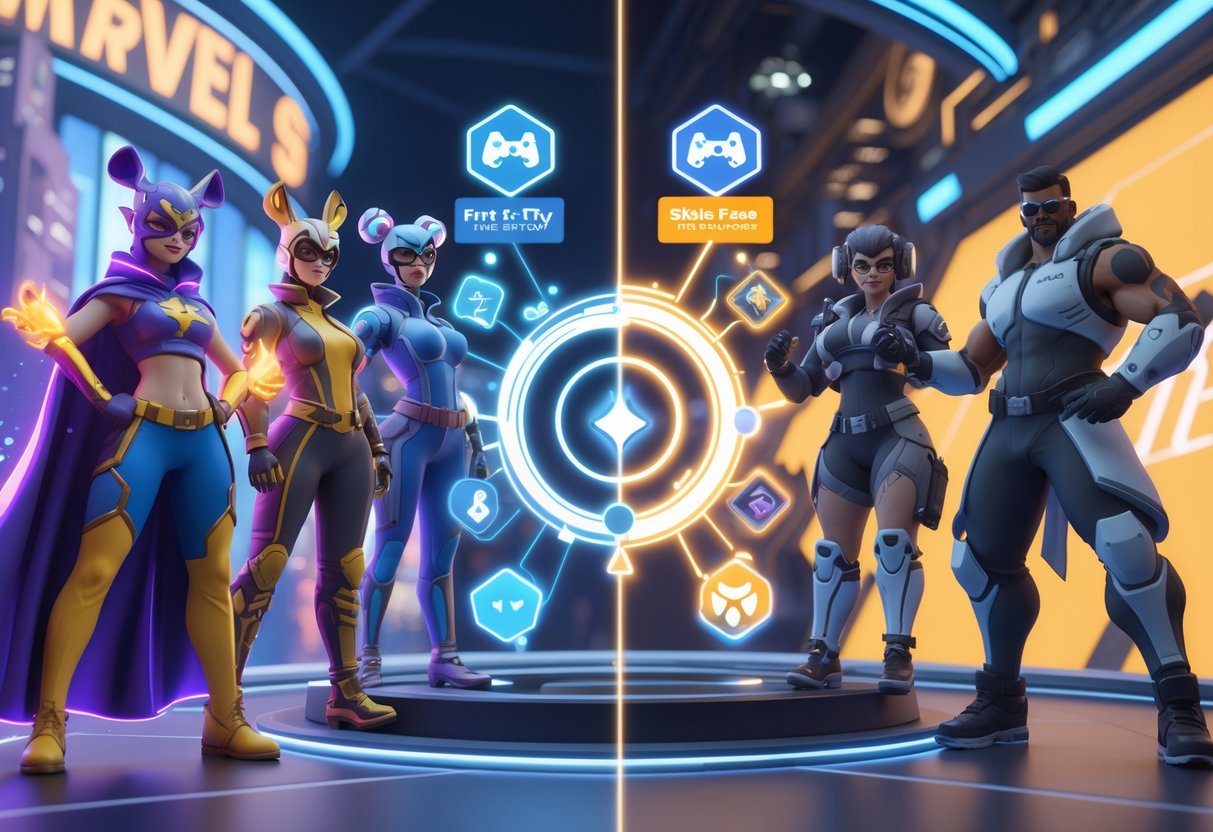
Both Marvel Rivals and Overwatch 2 are free-to-play, so you can jump in without paying. The real difference comes down to how they price cosmetics and structure their battle passes.
Available Content at Launch
Marvel Rivals gives full access to all heroes, maps, and game modes right from the start. You won’t hit a paywall for gameplay content.
You can play every character without grinding or paying. That keeps the competitive experience fair for everybody.
Overwatch 2 also gives free access to most maps and modes.
But new heroes usually appear in the premium battle pass first. Free players have to wait or grind out challenges to unlock them.
That gives paying players an edge for a while, especially when new heroes shake up the meta.
It’s a big deal for competitive fairness. Marvel Rivals doesn’t tie gameplay advantages to spending, while Overwatch 2’s hero releases can tip the scales for premium players.
Skin Acquisition and Microtransactions
Marvel Rivals runs on two currencies: Lattice (premium) and Units (earnable). You can swap Lattice for Units at a 1:1 rate.
Cosmetic bundles cost between 1,600-2,400 Units, depending on rarity. Epic bundles are about £13-16, legendary ones run £20-24.
The Luxury Battle Pass costs 490 Lattice (about £4) for Season 0. Future seasons will get pricier, but we don’t know the new price yet.
Overwatch 2 usually charges £15-20 for premium skins. Legendary skins cost 1,900 Overwatch Coins, which is about £16.
Their battle pass is 1,000 Coins (roughly £8.50), and you get some premium currency back for completing it. That can help pay for the next one.
Both games give out some free cosmetics through achievements and events. Marvel Rivals is more generous here, even offering epic costumes in the free pass.
Pricing is similar overall, but Marvel Rivals currently gives better value with bundle discounts and a cheaper battle pass.
Community Reception and Player Base
Marvel Rivals has built up serious momentum by putting the community first. Overwatch 2, meanwhile, keeps struggling with player satisfaction and keeping people around. The numbers don’t lie—player preferences are shifting.
Fan Engagement and Social Features
Players have responded really well to Marvel Rivals since launch. The game hit 10 million players in just 72 hours and still holds strong engagement months later.
Steam reviews show the difference in mood. Marvel Rivals sits at 81.3% positive reviews. Overwatch 2? Only 22.1% positive. That says a lot about how people actually feel.
Marvel Rivals boosts community interaction with:
- A team-up system that rewards coordination
- Regular seasonal updates
- Devs who talk openly about future plans
- Cross-platform play that brings everyone together
Overwatch 2’s community trust took a big hit after some rough decisions. Removing the original game, switching to 5v5, and changing monetisation all left longtime fans feeling burned.
Growth of the Hero Shooter Genre
Marvel Rivals’ success is shaking things up in the hero shooter world. Developers have to innovate now, not just coast on old formulas.
Current player engagement:
| Metric | Marvel Rivals | Overwatch 2 |
|---|---|---|
| Steam Peak (30 days) | 239,486 | 36,182 |
| All-time Steam Peak | 642,333 | 75,361 |
| Steam Review Score | 81.3% | 22.1% |
Healthy competition is good for everyone. Marvel Rivals brings in destructible environments and flexible teams. Overwatch 2 tries to keep up with new modes and balance tweaks, but sometimes it’s just not fast enough.
The genre is moving beyond the basics. Players now expect steady content updates, fair monetisation, and devs who actually listen. Games that don’t keep up risk losing their communities.
Competitive Play and Esports
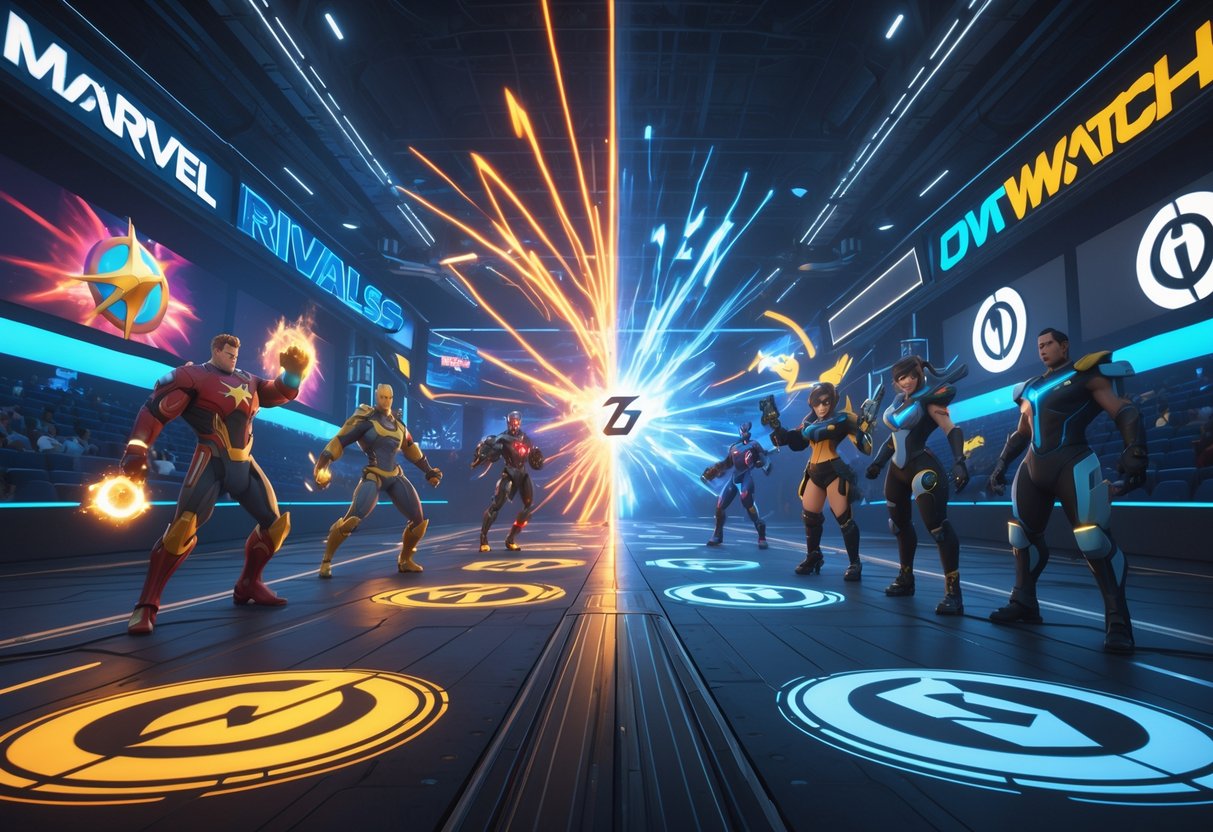
Overwatch 2 still rules the competitive esports scene with established tournaments and pro leagues. Marvel Rivals is more about casual play for now, with no major competitive scene yet. Both games offer ranking systems, but Overwatch 2’s competitive setup is way more developed.
Ranking Systems and Tournaments
Overwatch 2 gives players a full competitive ranking system with seven skill tiers, from Bronze up to Grandmaster. You compete in seasonal rankings that reset every few months. The game hosts big tournaments like the Overwatch League with million-dollar prize pools.
Overwatch 2 Competitive:
- Rankings from Bronze to Grandmaster
- Seasonal resets
- Role-specific ranks for each class
Marvel Rivals doesn’t have a formal competitive ranking system yet. It’s all about casual matchmaking—no ranked tiers or seasons.
Most players see Overwatch 2’s competitive mode as more structured but also more intense. Marvel Rivals is for folks who want fun without the stress of rankings.
Esports Scene Development
Overwatch 2 runs a full esports ecosystem, with pro leagues across regions. The Overwatch League has franchised teams, loyal fans, and big sponsors.
Current Tournament Scene:
- Overwatch League: Pro, franchised league
- Overwatch World Cup: International teams
- Regional tournaments: Lots of prize money each year
Marvel Rivals hasn’t made any moves into esports yet. NetEase hasn’t announced tournaments or leagues. With its casual focus, competitive play doesn’t seem like a priority for now.
Some industry watchers think Marvel Rivals could build a competitive scene if its player base stays strong. But Overwatch 2’s eight-year head start gives it a huge edge in tournaments and pro player support.
Future Updates and Ongoing Support
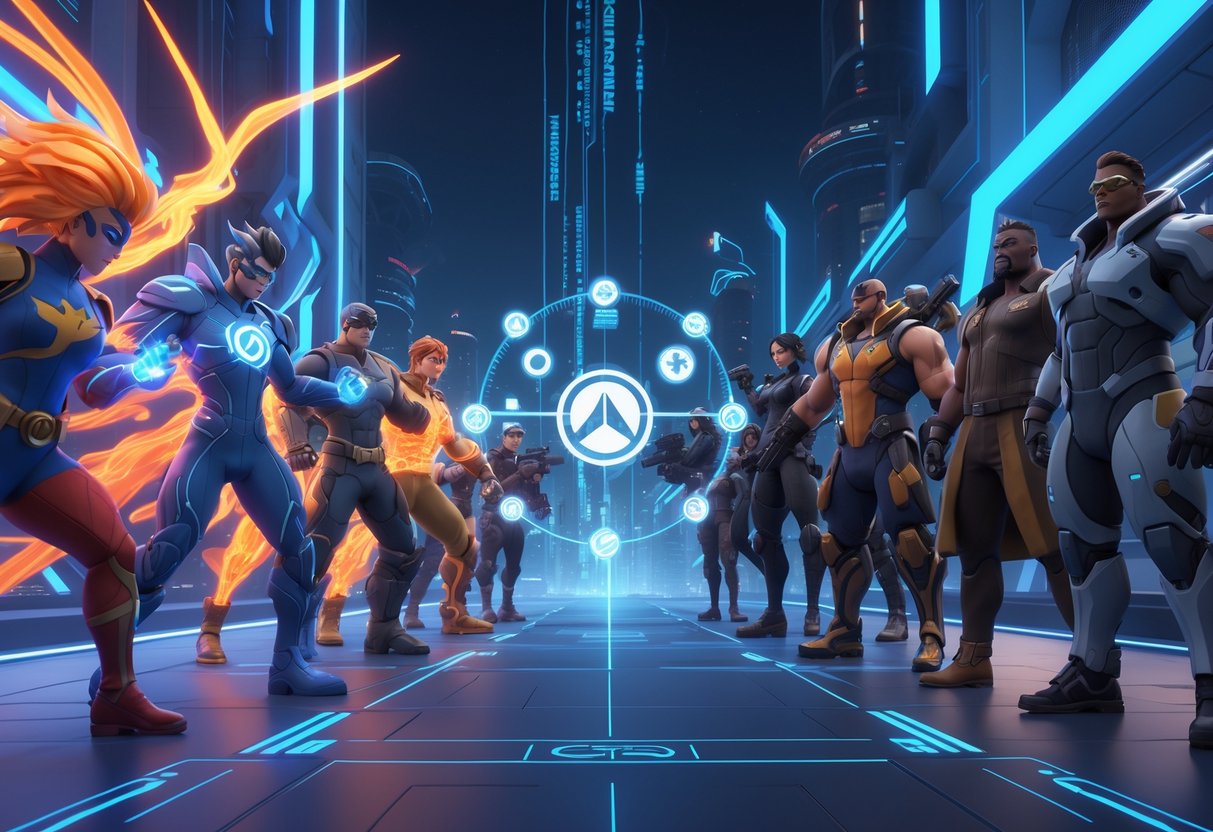
Both games promise regular content drops, but they don’t really do it the same way. NetEase has laid out some pretty ambitious expansion plans for Marvel Rivals, while Overwatch 2 sticks to updating what’s already there.
Roadmaps and New Content
Marvel Rivals plans to release new characters every quarter through 2025. NetEase aims to add 12 heroes by the end of the year, pulling from Marvel’s massive lineup—think X-Men and Fantastic Four.
They’ll roll out new maps every two months. Leaks suggest places like Wakanda and Asgard will show up soon.
They’ve already tied seasonal events to Marvel movie releases. The Deadpool & Wolverine event was a hit, so you can expect more of that.
Overwatch 2 goes for smaller, more frequent updates. Blizzard drops balance patches every three weeks, and new heroes show up every four months.
Their 2025 roadmap puts hero reworks front and center. Mercy and Reinhardt are first in line for big ability changes.
New game modes come out every quarter. Stadium mode, with its third-person view, was a direct answer to Marvel Rivals’ growing popularity.
Developer Communication
NetEase stays active on social media and posts development blogs every month. They even reply to community feedback on Reddit.
Players get to see behind-the-scenes stuff, like motion capture sessions with voice actors. That kind of transparency has gone over well.
Community events happen every week, including developer livestreams where the team answers questions live. This really helps the devs and fans connect.
Blizzard’s approach used to be more old-school, but it’s shifting. Director Aaron Keller now hosts monthly updates to address community concerns.
Patch notes have gotten way better. Blizzard now explains why they make certain balance changes, which helps players understand the decisions.
Beta testing programs let dedicated players shape both games. Overwatch 2’s experimental card system still offers more depth than what Marvel Rivals currently has.
Frequently Asked Questions
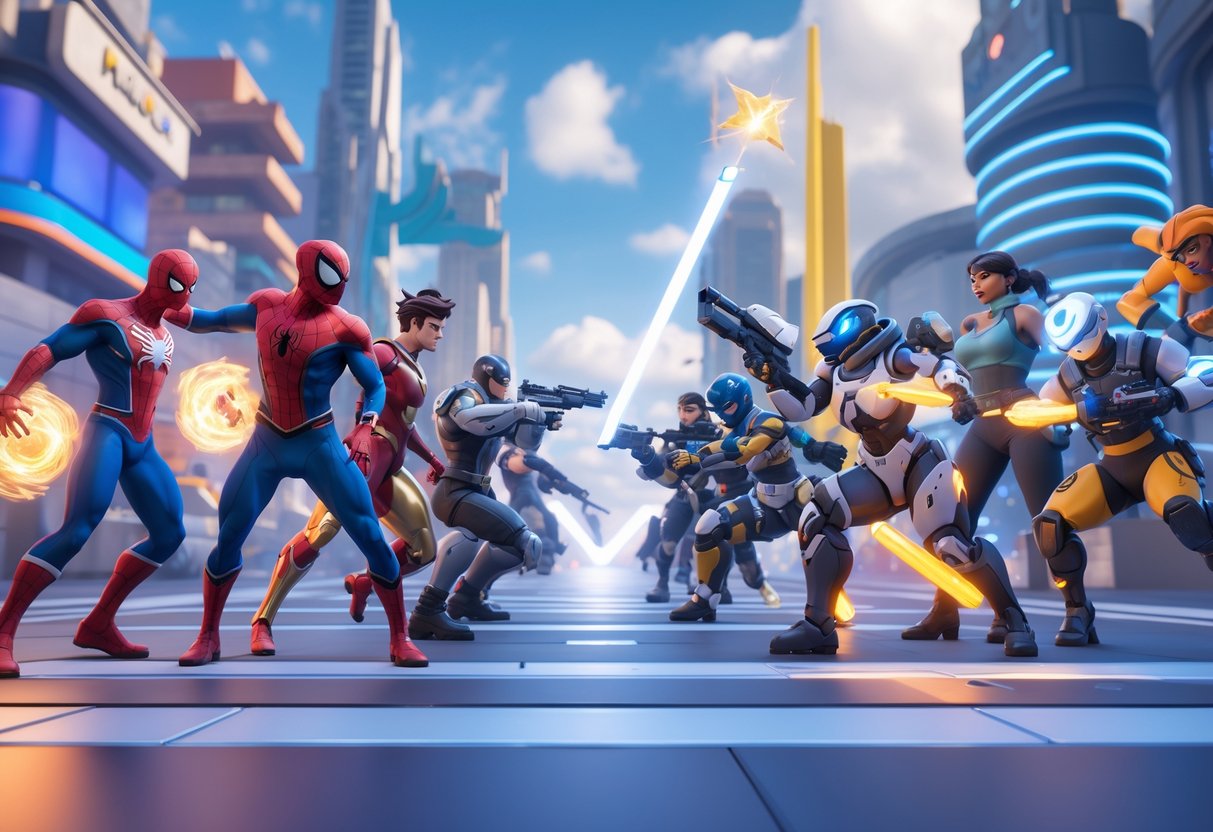
Both games are hero shooters, but they split on team composition, monetization, and how you unlock characters. Marvel Rivals gives you more freedom with 6v6 matches and no role locks, while Overwatch 2 keeps things structured with 5v5 and a battle pass.
What are the main differences between the gameplay mechanics of Marvel Rivals and Overwatch 2?
Marvel Rivals goes with 6v6 teams and skips role locks. You can swap to any hero mid-match, depending on what your team needs.
Overwatch 2 sticks to 5v5 with strict role queues. Teams always have one tank, two damage, and two support players.
Marvel Rivals has a team-up system where certain hero combos, like Rocket Raccoon and Groot, unlock special abilities you won’t see otherwise.
Destructible environments play a huge part in Marvel Rivals. Breaking walls or structures can open up new lines of sight or block off enemies.
Can you compare the character roster size and diversity between Marvel Rivals and Overwatch 2?
Overwatch 2 currently offers around 37 heroes, all split into tank, damage, or support roles. Each character fits neatly into one of those categories.
Marvel Rivals started with fewer heroes, but the roster pulls from the entire Marvel universe. You get characters like Spider-Man, Magneto, and Hulk, each with unique skills.
Unlocking characters works differently. Marvel Rivals lets everyone play all heroes for free right from the start.
Overwatch 2 makes new players unlock heroes through progression. Some of the latest additions are locked behind the battle pass.
How do the graphics and art styles in Marvel Rivals contrast with those in Overwatch 2?
Marvel Rivals uses Unreal Engine 5, so character models look pretty close to the Marvel movies. Visual effects show off destructible environments and flashy hero powers.
Overwatch 2 keeps its cartoon-like art style from the first game. Every hero and map sticks to that animated look.
Marvel Rivals puts more pressure on your graphics card. Most people see 90-120 FPS on mid-range PCs during big fights.
Overwatch 2 is lighter on hardware. Players usually get 144+ FPS on similar setups.
Could you discuss the respective online multiplayer experiences of Marvel Rivals and Overwatch 2?
Marvel Rivals keeps queue times under 30 seconds, no matter when you log in. Player counts stay high across different regions.
Overwatch 2 queue times really depend on your role. Damage players sometimes wait 5-10 minutes, especially off-peak.
Marvel Rivals reached 644,000 peak concurrent players on Steam. Lobbies stay active pretty much all day.
Overwatch 2 averages about 32,000 peak players daily on Steam, but most folks play through Battle.net anyway.
What are the differences in the progression systems between Marvel Rivals and Overwatch 2?
Marvel Rivals includes currency in every battle pass. You can actually earn enough credits to buy next season’s pass if you play regularly.
Overwatch 2’s battle pass locks legendary skins behind a paywall—£20 or more for some cosmetics. Premium stuff usually means spending real money.
Both games add seasonal content. Marvel Rivals leans into story-themed cosmetics that tie back to the characters.
Overwatch 2 gives players hero challenges and seasonal events. You unlock sprays, voice lines, and victory poses just by playing.
How do the strategies and team dynamics in Marvel Rivals compare to those in Overwatch 2?
Marvel Rivals really lets teams mix things up without locking anyone into a specific role.
Players usually figure out a good balance on their own, depending on the map and what the other team’s doing.
In Overwatch 2, everyone has to work together around that one tank in the lineup.
Support heroes need to watch their positioning since they don’t have an off-tank watching their back anymore.
Marvel Rivals makes it fun to pick heroes that go well together.
If you choose the right combo, you can pull off some pretty wild team-up moves.
Meanwhile, Overwatch 2 leans heavily on when and where you use those ultimate abilities.
Teams need to stack their defensive and offensive ults just right if they want to come out on top.









